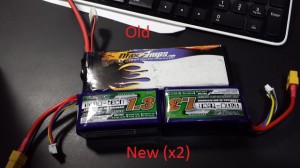New Components, Part 2
By Tuan Vo, Project Manager
Battery:
When picking the battery, three requirements must be taken into consideration. 1) the battery must have enough power to run the fans for the required amount of time. 2) the discharge rate must be high enough to provide the fan with required current to operate. 3) weight must be minimal.
The battery provided used by the last group is a big 3250mAh with 150C discharge rate giving constant amperage of 487.5A. According to the motor battery study (see blog) by Jake Rice, this battery is more than enough to power 4 fans for the required time. However, the battery was selected with 6 fans in mind and is too big and heavy, weighing in at 327grams. We can reduce the battery size with any combination of batteries that meet the power requirement. One battery powering all 4 fans or two batteries powering 2 fans each are the simplest and most logical way of powering our fans.
In order to fit the battery into the body of the aircraft, it is easier to use two smaller batteries instead of one bigger batteries. We’ve decided on two smaller LiPo batteries from HobbyKing.
Chosen: Turnigy LiPo battery (4S or 4cell). 1300mAh 45-90C, max 100C. 14.8V. (HobbyKing, Malaysia).
This battery can power two motors which draw current at a maximum theoretical 27*2=54A. At minimum, this battery can output 1.3Ah*45C=58.5A which is enough even for max current draw. According to last project’s current draw study, two fans would draw current at 11.17A*2=22.34A; to run this for two minutes we would need a battery of size 745mAh. (Current*time) The 1300mAh battery capacity would give us an extra 42.7% capacity over minimum.
The weight of two batteries is 155grams*2=310grams, which is 17 grams less than the MaxAmps battery used by last semester. We shaved off some weight without spending too much money. These two new batteries cost a total of 45$ including shipping.

